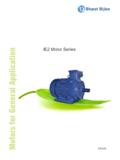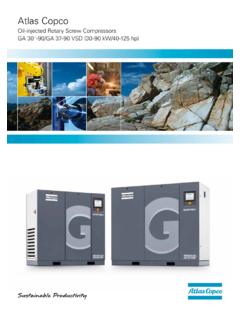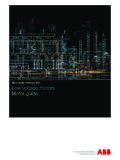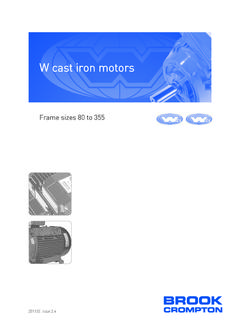Transcription of CGIE/A - Bharat Bijlee Ltd.
1 CGIE/AMotors for General ApplicationIE2 Motor SeriesIntroduction Global warming is a reality and world over people are working towards reduction in carbon foot motor applications, in Indian industry, consume about seventy percent of the generated electrical energy. Improving efficiency of the motor is therefore a major concern in energy- efficiency efforts. Electric motors with improved efficiency , in combination with frequency converters can save about 7% of the total worldwide electrical energy. Roughly one quarter to one third of these savings come from the improved efficiency of the motor. A need was felt amongst users, consultants and manufacturers in India to revise existing BIS standard IS 12615:2004 to harmonize with the international standards. This will lead us to be in line with international code of standards and practices. This will also result in having uniform test procedures to facilitate the end user to compare the performance and energy efficiency of from to 375kW make up the vast majority (approximately 90%) of installed motor population and are covered by the standard IS 12615:2011.
2 This fulfills the need of the manufacturers to design motor for a global market. This standard defines four efficiency classes for nominal frequency features of BIS standard IS 12615:2011 (second revision)This standard is primarily based on IEC 60034-30:2008 issued by the International Electrotechnical Commission except that additional performance parameters other than efficiency values have also been included. The efficiency levels in IS 12615:2011 are based on test methods specified in IS 15999 (Part 2/sec 1):2011 / IEC 60034-2-1:2007. The standard specifies methods used to determine losses and efficiency , with the objective to calculate efficiency values more IE efficiency classes are as given belowEfficiency ClassDescriptionIE1 Standard efficiencyComparable to eff2IE2 IE3 IE4 High efficiencyComparable to eff1 PremiumPremiumSuper premiumSuper premiumAs per the standard, efficiency class of IE4 is under consideration and would be incorporated later.
3 The standard IS 12615:2011 covers low voltage, AC three phase squirrel cage, single speed induction motors for Rated voltage <= 1000V Rated frequency 50Hz Rated output between to 375kW 2P, 4P & 6P Rated on the basis of continuous duty (S1) or intermittent periodic duty (S3) with 80% or higher cyclic duration factor Capable of operating direct on line Rated for ambient temperature of 40 deg centigrade & altitude not exceeding 1000m Degree of protection IP44 or superior Method of cooling IC 411 Fixing dimensions as per IS 1231 & IS 2223 Determination of total losses with PLL determination from residual lossesThis standard does not cover 8P motors Pole changing motors ( multispeed motors) Motors made exclusively for converter duty application Motors completely integrated into the machine. (for example, pumps, compressors that cannot be tested separately from the machine ) Crane & hoist duty motorsHighlights efficiency values of different manufacturers are comparable only if they are measured by the same method as per IS 15999 (Part 2/sec 1):2011 / IEC 60034-2-1:2007.
4 IE Class efficiencies are subject to tolerance as per IEC 60034-1 For conditions of limitations on grid supply ( limiting starting current, high tolerances of voltage and/or frequency), it may not be possible to achieve the same IE efficiency class. Energy efficient cage-induction motors are typically built with more active material to achieve higher efficiency and hence the starting performance of these motors differ somewhat from motors with a lower efficiency . The locked rotor current increases approximately by 10 to 15 percent for increase in each level of efficiency for the same output power. For replacing existing motors, this should be checked by the user with manufacturer for proper sizing of the protective devices. Old efficiency levels were Eff2 and Eff1 (as per CEMEP). For calculation of these efficiencies, fixed stray load losses ( of motor output) were assumed.
5 Now IS 12615:2011 refers to IS 15999 (Part 2/sec 1):2011 / IEC 60034-2-1:2007 for calculation of efficiency . This calculation is based on the new methods of stray load loss measurement specified in the standard. The effect is in the reduction of efficiency as compared to the earlier values. Energy Efficient Induction Motors(Three phase squirrel cage induction motors) Bharat Bijlee has introduced a complete range of IE2 High efficiency motorsProduct RangeType Frame Size kW range2H - IE2 High efficiency 71 TO 355L TO 355*Standards All motors comply with following Indian & International standardsNational/International StandardsIS : 325 Three Phase Induction motors 60034-1 Rotating electric machines: Part 1 Rating and performance IS : 900 Code of practice for installation & maintenance of induction : 1231 Dimensions of foot mounted Induction motorsIS.
6 2223 Dimensions of Flange mounted Induction motorsIS 15999 part 2 Rotating Electrical Machines - section 1 Standard Methods for determining /IEC 60034-2-1 losses and efficiency from tests IS /IEC 60034-5 Degree of protection provided by the integral design of Rotating Electrical Machines (IP code) : classificationIS : 6362 / Designation of methods of coolingIEC 60034-6 for Rotating Electrical MachinesIS : 12065 / Permissible Limits of noise levelIEC 60034-14 for Rotating Electrical Machines IS : 12075 Mechanical Vibration of Rotating Electrical MachinesIS : 12615:2011 Energy Efficient Induction Motors Three phase Squirrel 60072 Dimension & Output rating of Rotating Electrical MARKAll motors have CE mark on the nameplateELECTRICAL FEATURESS tandard Operating conditionSupply Conditions (Voltage & Frequency)Voltage : 415 V 10%Frequncy : 50Hz 5%Combined variation : 10%Ambient oMotors are designed for ambient temperature of 50 CAltitude Motors are designed for an altitude up to 1000m above mean sea factorsThe re-rating applicable under different conditions of supply voltage, frequency, ambient & altitude are obtained by multiplying following in supply Voltage & Frequency 10 5 10 100 5 95 15 5 15 90 Voltage Variation % Frequency Variation % Combined Voltage & Frequency Variation %Permissible output as % of rated value*Note : Motors above 355kW & up to 1250kW areavailable in frame size 355, 400 & 450 with doubleventilated cooling system.
7 Please contact our in Ambient Temperature & AltitudeMethod of starting Our motors are suitable for following method of startingkW rating Method of starting No. of leadsUpto & including kW DOL 6 415V - Star 240V - Delta Above kW DOL or Star / Delta 6 All Bharat Bijlee motors are suitable for inverter duty application. (Refer page 5)Starting Time and Duty CycleMotors are designed for continuous (S1) Duty. Other type of duty (S2 to S9) can be offered on request. The motors can safely withstand 3 consecutive starts from cold condition & 2 consecutive starts from hot conditions. In applications where more severe starting conditions are encountered, a special enquiry should be made Drives with high inertia flywheel drives, eccentric presses, large fans etc. Drives involving intermittent duty of motors with frequent starts rolling mills, centrifuges and conveyor motors, etc.
8 The enquiry should be accompanied with following GD and relevant speed of driven equipment Duty cycle/sequence of operation/no. starts/hours Speed-Torque diagram of driven equipment Method of braking (Electrical or Mechanical)Insulation and EnduranceThe Motors are provided with class F insulation scheme with temperature rise limited to class B. These motors can be used 0either at ambient temperature of 55 C or overloaded continuously by 10% (service factor = ). The temperature rise will be still within limits of class F. The slot insulation consists of Nomex-polyster-Nomex (NPN). All insulation materials used are adequately resistant to the action of microbes and & Insulation for Inverter Duty Motors The stators are wound with polysteremide coated with polyamide-imide top coat, (dual coated) wires as per IS 13730 : part 13, grade -II thermal class 200 copper wires.
9 Vacuum Pressure Impregnation (VPI) is provided to on the voltage wave rise time (dv/dt) and the maximum peak to peak voltage at the motor terminals, suitable insulation schemes are customer's demand, insulated bearings are offered from frame size 132 and onwards on the NDE side of the motor. OptionsMotors with class 'H' insulation can be offered on request. Thermal Protection (For Winding & Bearing)PTC Thermisters / thermostats. RTD etc. can be embedded in stator winding on request. In case of frame sizes 250M & above Bearing Temperature Detectors (BTD) can be supplied on Terminals Two earthing terminals are provided on the body and one terminal is provided in the terminal MethodIn order to avoid condensation of water inside the motors, they can be heated up by connecting a voltage 4 to 10% of rated voltage to the motor terminals.
10 Adequate heating is obtained with current equal to 20-25% of rated motor current. Alternatively any of the methods indicated in IS : 900 for heating stator winding could be can also be offered with built in space heaters in frame size 90 and FEATURES Enclosures: ( Material & Terminal box location)Motors are offered with following enclosureFrame Size Enclosure Materials Standards Option Available63-80 Aluminum TOP ----90S-112M Aluminum TOP ---- Cast Iron RHS TOP & LHS132S & 132M Aluminum TOP -132S-225M Cast Iron RHS TOP & LHS250M-355L Cast Iron TOP RHS & LHST erminals Box LocationDegree Protection All motors have IP55 degree of protection as per IS/IEC 60034-5. Higher degree of protection such as IP56, IP66 can be provided on request. All flanged motors are additionally provided with oil tight shaft protection on driving end 2 Cooling TypeCooling CodeTEFC IC 411 StandardTENV IC 410 On DemandFORCED COOLED IC 416 On DemandAll foot mounted motors are with integral feet construction.





